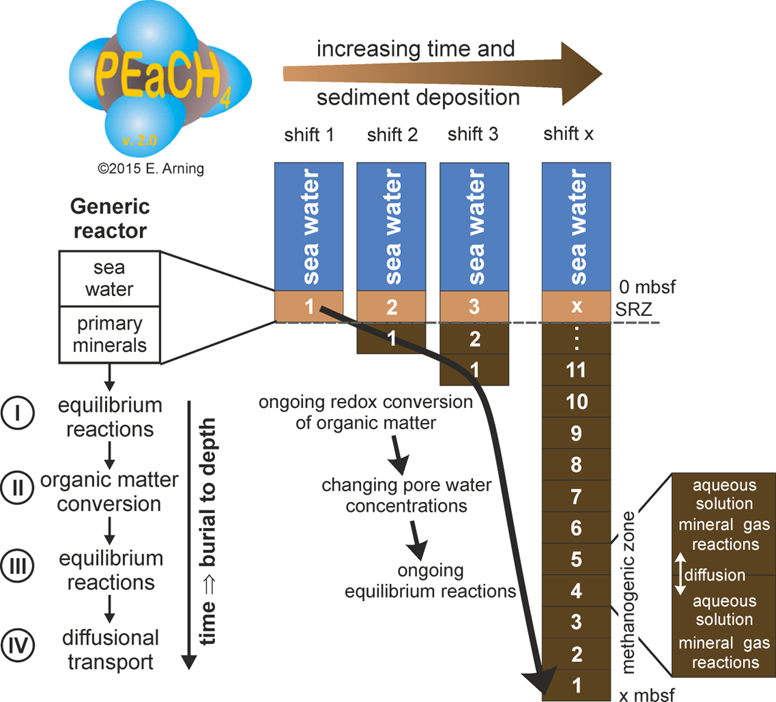PHREEQC based modelling platform PEaCH4 v. 2.0
PEaCH4 v. 2.0 provides a modelling platform to predict, but also to retrace early diagenetic processes in marine sediments. The modelling tool is the PHREEQC computer code that is applied to calculate chemical equilibrium species distribution among aqueous solutions, minerals and gases. This is combined with one-dimensional diffusion-driven transport and the irreversible redox-conversion of metabolizable organic matter. PHREEQC is coupled to an excel© platform of PEaCH4 v. 2.0. The main task of PEaCH4 v. 2.0 is to predict quantitatively the formation of biogenic methane, the fraction of other gases (CO2, N2, H2S) within the multi-component gas, and the amount of precipitated diagenetic minerals. PEaCH4 v. 2.0 describes a growing sediment column. The model describes a reactor that is filled by one liter of defined sea water and sediments of a defined mineral composition and porosity at the first time step. The driving force for the formation of diagentic products in PEaCH4 v. 2.0 is the irreversible redox-conversion of metabolizable organic matter. The kind (marine or terrestrial) of the converted organic matter can be defined. Reaction kinetics of organic carbon conversion is integrated into the set of equilibrium reactions by the amount of converted organic carbon in each time step.
Goals
- quantitatively determine the formation of biogenic methane (CH4(aq), CH4(g), CH4-hydrate(s))
- quantitatively determine the amount of precipitated diagenetic minerals and mineral dissolution
- quantitatively determine pore water chemical composition during early diagenesis
PEaCH4 v. 2.0 is one major development in the BioMeP-2 project.
Participants
- Hans-Martin Schulz
- Esther Arning
- Steffen Häußler
Partners
- Petrobras
- Total
- Prof. Wolfgang van Berk, TU Clausthal
Publications
- Arning ET, van Berk W, Schulz H-M (submitted) Marine organic matter in reaction transport models: revision and validation of the traditional “CH2O”. Geo-Marine Letters.
- Arning ET, Gaucher EC, van Berk W, Schulz H-M (2015) Hydrogeochemical models locating sulfate-methane transition zone in marine sediments overlying black shales: A new tool to locate biogenic methane? Marine and Petroleum Geology 59: 563-574. doi: 10.1016/j.marpetgeo.2014.10.004.
- Krüger M, van Berk W, Arning ET, Jinménez N, Schovsbo NH, Straaten N, Schulz H-M (2014) The biogenic methane potential of European gas shale analogues: Results from incubation experiments and thermodynamic modelling. International Journal of Coal Geology 136: 59-74. doi:10.1016/j.coal.2014.09.012.
- Arning ET, van Berk W, Schulz H-M (2013) Thermodynamic modeling of complex sediment-water-gas interactions during early diagenesis. Procedia Earth and Planetary Science 7: 27-30. doi: 10.1016/j.proeps.2013.03.090.
- Arning ET, van Berk W, Vaz dos Santos Neto E, Naumann R, Schulz H-M (2013) Quantification of methane formation in Amazon Fan sediments (ODP Leg 155, Site 938) by means of hydrogeochemical modelling solid – aqueous solution – gas interactions. Journal of South American Earth Sciences 42: 205-215. doi:10.1016/j.jsames.2012.12.001.
- Arning ET, van Berk W, Schulz H-M (2012) Quantitative geochemical modeling along a transect off Peru: Carbon cycling in time and space, and triggering factors for carbon loss and storage. Global Biogeochemical Cycles 26: 1-18. doi:10.1029/2011GB0074156.
- Arning ET, Fu Y, van Berk W, Schulz H-M (2011) Organic carbon conversion as the control of complex, early diagenetic solid – aqueous solution – gas interactions: Case study ODP Leg 204, Site 1246 (Hydrate Ridge). Marine Chemistry 126: 120-131. doi:10.1016/j.marchem.2011.04.006
